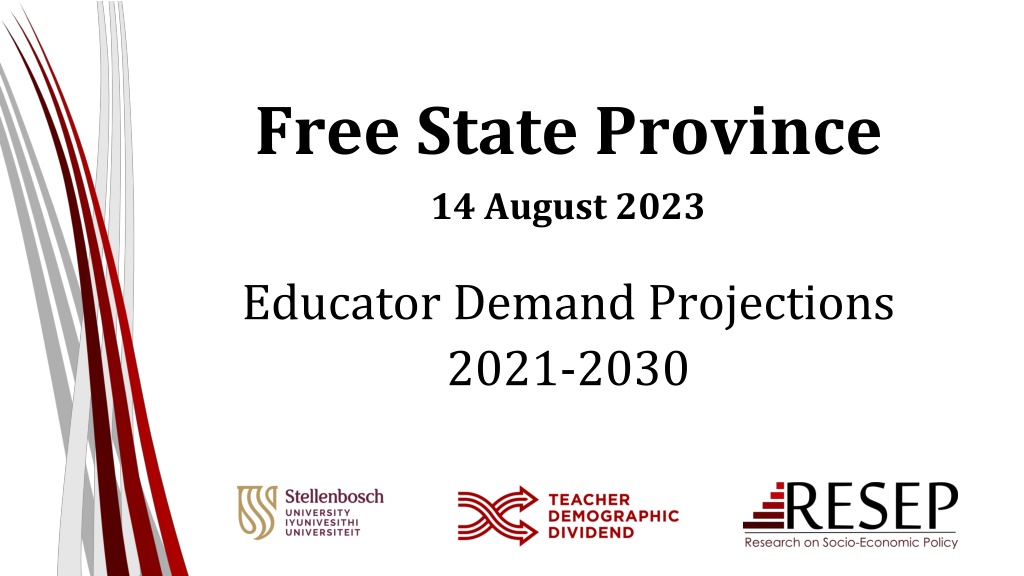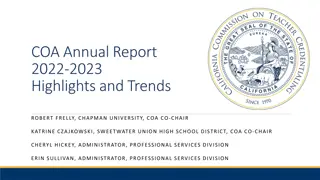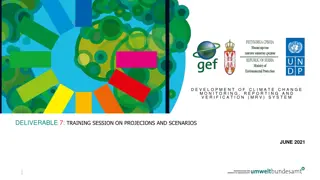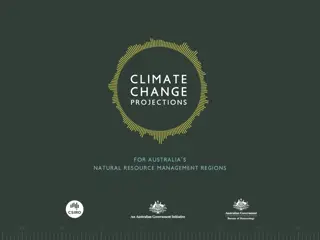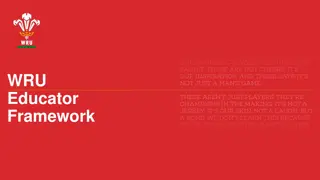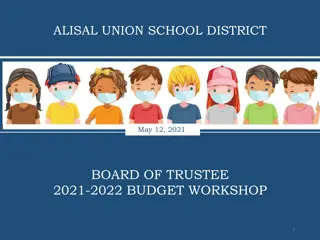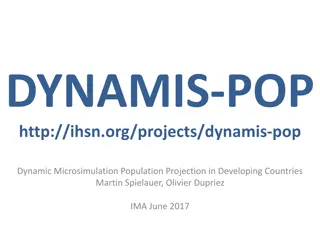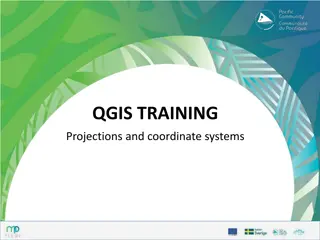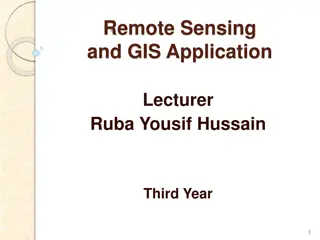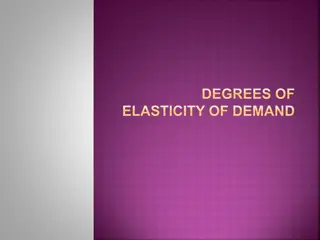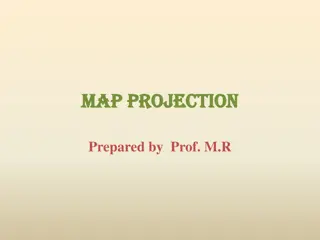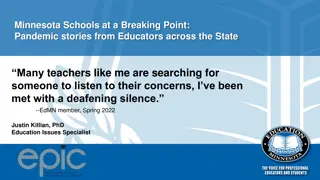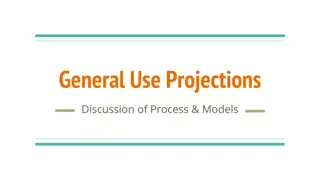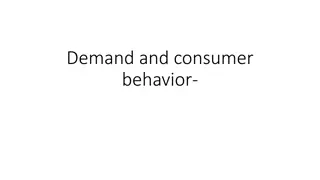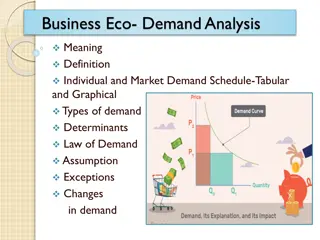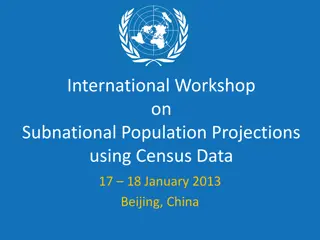Free State Province Educator Demand Projections 2021-2030
The Free State Province in South Africa is facing a wave of educator retirements, leading to the need for more appointments to fill teaching and management positions. This presentation explores the implications of this retirement wave, expected growth in learner enrollment, and the importance of province-specific planning.
Download Presentation

Please find below an Image/Link to download the presentation.
The content on the website is provided AS IS for your information and personal use only. It may not be sold, licensed, or shared on other websites without obtaining consent from the author.If you encounter any issues during the download, it is possible that the publisher has removed the file from their server.
You are allowed to download the files provided on this website for personal or commercial use, subject to the condition that they are used lawfully. All files are the property of their respective owners.
The content on the website is provided AS IS for your information and personal use only. It may not be sold, licensed, or shared on other websites without obtaining consent from the author.
E N D
Presentation Transcript
Free State Province 14 August 2023 Educator Demand Projections 2021-2030
Introduction (1) The proportion of educators that are 50 years or older has steadily risen between 2012 to 2021 in South Africa. Nationally a wave of educator retirements is expected as older educators reach the standard retirement age of between 60 and 65. Implications: Many more appointments: The retirement wave will open up both teaching & school management & leadership positions & other office- based education specialists. Total compensation of educators: Since older teachers earn more, when retiring they are replaced with younger (less costly) teachers.
Introduction (2) As retirements increase, the required number of new appointments will need to increase to ensure that total educator numbers (at a minimum) stay at current levels and/or are sufficient to meet learner enrolment growth to prevent deterioration in learner-educator ratios. Planning will be required to ensure that provinces are ready for the sustained increase in appointments. If these positions are not filled, this could result in a further deterioration in the learner-educator ratio and lead to further increases in already large class sizes.
Introduction (3) Educator age distribution in 2012 & 2021 in SA Peak in age shifted from 46 years to 53 years 6.0% % of educators at this age 5.0% 4.0% 3.0% 2.0% 1.0% 0.0% 21 26 31 36 2012 41 46 51 56 61 2021 Source: Anonymised PERSAL data from 2021, only educators (Rank 60 000 69 999) are considered. ECD practitioners, TVET lecturers and ABET teachers were removed.
Objective In each province there are some differences in the age profile of teachers, differences in the expected growth of the school-going population and differences in expected teacher attrition (resignations & retirements). The year of the retirement wave peak will differ across provinces. Also some provinces need to accommodate much more growth in learners than others. In this presentation, we highlight the situation in the Free State to inform province-specific planning.
Overview 10 Age distributions Projected retirements & resignations Provincial population and enrolment trends Public and independent school growth Educator growth: Teachers and SMT positions The implications for appointments and class sizes Expected financial implications to 2030 Movement of educators: Between and within provinces Gender imbalance in school management Discussion 1 2 3 4 5 6 7 8 9
Free State educator demand summary Age distribution: The age distribution in the FS had a peak at around 51 years of age in 2021 Projected resignations and retirements: About half of the educators that exit PERSAL are age-related retirements (ages 56 to 65); the number of senior educators (SMT positions and other specialists) that are retiring is expected to increase (65% were 50+ years old in 2021) Enrolment and population growth: Enrolment in the FS ordinary schools increased by 10% from 2012-2021 (~65K learners), and the school-aged population is forecast to decline by -4% (~26K learners) to 2030, which will likely result in lower enrolments. School rationalisation may need to continue as a result of the decrease. School and educator growth: Between 2012 and 2021, the educator number has fallen (-13%), and the number of public ordinary schools has decreased (-27%), driving up the LE ratio and class sizes. SMT position changes: In the FS, there has been a large decline in the number of Principals between 2012 and 2021 (-27%), largely as a result of school rationalisation. The number of HODs (-8%), Deputy Principals (-10%) and teachers (-13%) have also declined over this period. Appointments and LE Ratio: The LE ratio increased from 24.1 to 30.0 between 2012 and 2021 Projected educator cost trends: The unit cost of educators is predicted to remain constant. Due to the change in age distribution. Educator movements: There is high movement out of the FS (~6%), and few educators move to the FS (<3%). About ~6% educators move between schools within the province.
1 2 Age distributions and projected retirements and resignations
1 Educator age distribution (2021) A lower proportion of educators are over 50 years old in the Free State than in the rest of the country 6.0% A slightly higher proportion of young educators under 35 years in the Free State than in the rest of the country % of educators at this age 5.0% 4.0% 3.0% 2.0% 1.0% 0.0% 21 26 31 36 41 46 51 56 61 FS SA Source: Anonymised PERSAL data from 2021, only educators (Rank 60 000 69 999) are considered. ECD practitioners, TVET lecturers and ABET teachers were removed.
1 Older teacher proportions for senior educator and primary schools educators Percentage of educators aged 50+ in 2021 Senior educators (HOD, Dep.- principals, Principals & Other) Primary school educators Province All educators EC 51% 71% 58% FS 43% 65% 49% GP 41% 65% 42% KN 39% 65% 44% LP 58% 81% 63% MP 50% 73% 55% NC 43% 69% 44% NW 47% 70% 52% WC 42% 73% 40% SA 49% 46% 69% Source: Anonymised PERSAL data from 2021, only educators (Rank 60 000 69 999) are considered. ECD practitioners, TVET lecturers and ABET teachers were removed. The 2021 rankclass file was expanded to include ranks found only in years prior to 2021, used to classify educators by rank. Primary school only includes all educators that are in a component that is classified as a Primary school.
1 Older teacher proportions for senior educator and primary schools educators Percentage of educators aged 50+ in 2021 Senior educators (HOD, Dep.- principals, Principals & Other) Primary school educators Province All educators EC 51% 71% zvc 58% FS 43% 65% 49% GP 41% FS has 43% of educators aged 50 years and older in 2021 with a higher proportion in primary schools (49%) 65% 42% KN 39% 65% 44% LP 58% 81% 63% MP 50% 73% zvc zvc 55% NC 43% 69% 44% NW 47% 70% 52% WC 42% 73% 40% SA 49% 46% 69% Source: Anonymised PERSAL data from 2021, only educators (Rank 60 000 69 999) are considered. ECD practitioners, TVET lecturers and ABET teachers were removed. The 2021 rankclass file was expanded to include ranks found only in years prior to 2021, used to classify educators by rank. Primary school only includes all educators that are in a component that is classified as a Primary school.
1 Educator age distribution in 2021 & 2030 Assume constant 2021 educator numbers Age: 51 5.0% % of educators at this age 4.5% 4.0% 3.5% 3.0% 2.5% 2.0% 1.5% 1.0% 0.5% 0.0% 21 26 31 36 41 46 51 56 61 FS '302021 FS 2030 Source: Anonymised PERSAL data from 2021, only educators (Rank 60 000 69 999) are considered. ECD practitioners, TVET lecturers and ABET teachers were removed.
2 Projected resignation & retirements (FS) Assume constant 2021 educator numbers Proportion of Educators About half of the educators that exit PERSAL in the FS are retiring (ages 56 or above) Large spike in resignations due to the pension reform rumours in 2015 The number of young teachers (ages 21-30) resigning is projected to increase as the number of newly hired young teachers increases. % of educators resigning or retiring Projected 16.0% 14.0% 12.0% 10.0% 8.0% 6.0% 4.0% 2.0% 0.0% Aged 21 to 30 Aged 31 to 55 Aged 56 to 65 Source: Anonymised PERSAL data from 2021, only educators (Rank 60 000 69 999) are considered. ECD practitioners, TVET lecturers and ABET teachers were removed. Estimates to 2035 derived from the National and provincial teacher supply and demand models assumption of no growth in educator numbers. Note: Retirements refer to all educators, aged 56 to 65, that leave PERSAL, whilst resignations refer to all educators aged 55 and below that leave PERSAL (as educators) for any reason.
2 Projected resignation & retirements (FS) Assume constant 2021 educator numbers Retirement headcount The number of retirements is projected to increase, peaking in ~2030 & 2031 and then declining The number of retirements is projected to increase from just over 700 in 2022 to just under 900 in 2030, an increase of about 200 retirements annually Projected 1000 Number of retirements 900 800 700 600 500 400 300 200 100 0 Source: Anonymised PERSAL data from 2021, only educators (Rank 60 000 69 999) are considered. ECD practitioners, TVET lecturers and ABET teachers were removed. Estimates to 2035 derived from the National and provincial teacher supply and demand models assumption of no growth in educator numbers. Note: Retirements refer to all educators, aged 56 to 65, that leave PERSAL, whilst resignations refer to all educators aged 55 and below that leave PERSAL (as educators) for any reason.
2 Older leaver trend estimates to 2035 Assume constant 2021 educator numbers Cumulative proportion of estimated leavers aged 56-65 as a proportion of total educators in 2022 About 11,300 educators estimated to retire by 2035 in the FS (50% of total educators in 2021) 60% 50% 40% 30% 20% 10% 0% FS SA Source: Anonymised 2021 PERSAL data, only educators (Rank 60 000 69 999) are considered. ECD practitioners, TVET lecturers and ABET teachers were removed. Estimates to 2035 derived from the National and provincial models assumption of no growth in educator numbers.
2 Projected educators leaving Assume constant 2021 educator numbers Teachers (School based teachers) Senior educators (HODs, Deputy s, Principals & Other) % of teacher resigning & retiring 12% 12% % of senior educators 10% 10% resigning & retiring 8% 8% 6% 6% While a lower proportion of senior educators are expected to leave relative to the SA average (from about 2025 onwards), careful succession planning is still needed during this period as high numbers of HODs, deputies and principals will be retiring by 2035 4% 4% A high proportion of teachers are expected to resign and retire in the FS 2% 2% 0% 0% FS SA Source: Anonymised 2021 PERSAL data, only educators (Rank 60 000 69 999) are considered. ECD practitioners, TVET lecturers and ABET teachers were removed. Estimates to 2035 derived from the National and provincial models assumption of no growth in educator numbers.
3 Provincial population and enrolment trends
3 Provincial enrolment trends (2012-2021) Ordinary school enrolment headcount 125% (Indexed with 2012 totals at 100%) GP WC High growth 120% 115% NW Moderate growth NC FS SA 110% MP 105% LP KN Stable 100% 95% Decline EC 90% 85% Source: Enrolment numbers taken from School Realities-EMIS (2012 2021) released by the DBE, using total numbers for ordinary public and independent schools.
3 Provincial enrolment trends (2012-2021) Ordinary school enrolment headcount 130% (Indexed with 2012 totals at 100%) Enrolment in Free State ordinary schools increased by 10% from 2012 to 2021 125% 120% 115% FSSA 110% 105% 100% 95% 90% 85% 80% Source: Enrolment numbers taken from School Realities-EMIS (2012 2021) released by the DBE, using total numbers for ordinary public and independent schools.
3 Correlation between population and enrolment growth (2012- 2021) R2= 0.9025 Strong positive correlation between population and enrolment growth between 2012 and 2021 45 Source: Thembisa age specific data V4.5 for school-aged population (Ages 7-18) estimates and enrolment taken from School Realities-EMIS (2012 2021) released by the DBE, for numbers on ordinary public and independent schools (Statistical Publications (education.gov.za))
3 Projected growth in school-aged population 27% 30% 25% Population of children aged 7-18 in the Free State, is expected to decrease by ~26K children (-4%) from 2021 to 2030 20% 15% 15% 10% 7% 6% 6% 4% 5% 1% -1% -4% 0% EC FS KN NC NW MP LP WC GP SA -5% -10% -15% -15% -20% Note: Period 2021 2030 is the same timeframe, nine years, as 2012 2021. Source: Thembisa age-specific estimates from the model V4.5 for children aged 7-18 by province
3 School aged-population estimates to 2030 Projected number of school-aged children (7-18 yrs) in Free State Number of children Aged 7-18 2012 2021 Growth '12-21 Growth '21-30 Province 2030E 800 000 676K 700 000 EC FS GP KN LP MP NC NW WC Total 1 657 202 592 445 1 962 793 2 485 822 1 395 864 977 749 254 075 742 943 1 068 009 11 136 902 12 541 746 13 337 172 1 598 475 676 489 2 498 533 2 690 378 1 507 386 1 100 594 277 560 893 530 1 298 801 1 361 637 650 820 3 180 884 2 657 716 1 612 125 1 165 728 281 208 930 323 1 496 731 -4% 14% 27% 8% 8% 13% 9% 20% 22% 13% -15% -4% 27% -1% 7% 6% 1% 4% 15% 6% 600 000 651K 592K 500 000 400 000 300 000 200 000 100 000 0 Note: Period 2021 2030 is the same timeframe, nine years, as 2012 2021. Source: Thembisa age-specific estimates from the model V4.5 for children aged 7-18 by province
4 Public and independent school growth
4 Educator, school and enrolment growth % growth from 2012 - 2021 Number of public ordinary schools Enrolment in public ordinary schools Enrolment in ordinary schools Number of educators Number of teachers Est. school-aged population Province EC FS GP KN LP MP NC NW WC SA -17% -13% 21% -5% -8% 3% 6% 2% 12% -1% -20% -13% 28% -3% -2% 7% 9% 4% 22% 2% -8% -27% 1% -3% -7% -8% -3% -9% 0% -6% -6% 9% 20% 1% 4% 7% 9% 12% 21% 7% -5% 10% 24% 1% 5% 8% 10% 13% 22% 8% -4% 14% 27% 8% 8% 13% 9% 20% 22% 13% Source: Educator numbers from anonymised PERSAL data from 2012 and 2021, only educators (Rank 60 000 69 999) are considered. Thembisa age specific data V4.5 for school-aged population (Ages 7-18) estimates and enrolment and school numbers taken from School Realities-EMIS (2012 2021) released by the DBE, for numbers on ordinary public and independent schools (Statistical Publications (education.gov.za))
4 Educator, school and enrolment growth % growth from 2012 - 2021 Number of public ordinary schools z Enrolment in public ordinary schools Enrolment in ordinary schools Number of educators Number of teachers Est. school-aged population Province EC FS GP KN LP MP NC NW WC SA -17% -13% 21% -5% -8% 3% 6% 2% 12% -1% -20% -13% 28% -3% -2% 7% 9% 4% 22% 2% -8% -27% 1% -3% -7% -8% -3% -9% 0% -6% -6% 9% 20% 1% 4% 7% 9% 12% 21% 7% -5% 10% 24% 1% 5% 8% 10% 13% 22% 8% -4% 14% 27% 8% 8% 13% 9% 20% 22% 13% The number of public ordinary schools declined in the Free State largely as a result of school rationalisation z Source: Educator numbers from anonymised PERSAL data from 2012 and 2021, only educators (Rank 60 000 69 999) are considered. Thembisa age specific data V4.5 for school-aged population (Ages 7-18) estimates and enrolment and school numbers taken from School Realities-EMIS (2012 2021) released by the DBE, for numbers on ordinary public and independent schools (Statistical Publications (education.gov.za))
4 Educator, school and enrolment growth % growth from 2012 - 2021 Number of public ordinary schools z Enrolment in public ordinary schools Enrolment in ordinary schools Number of educators Number of teachers Est. school-aged population Province EC FS GP KN LP MP NC NW WC SA -17% -13% 21% -5% -8% 3% 6% 2% 12% -1% -20% -13% 28% -3% -2% 7% 9% 4% 22% 2% -8% -27% 1% -3% -7% -8% -3% -9% 0% -6% -6% 9% 20% 1% 4% 7% 9% 12% 21% 7% -5% 10% 24% 1% 5% 8% 10% 13% 22% 8% -4% 14% 27% 8% 8% 13% 9% 20% 22% 13% The number of school-aged children and enrolment in public ordinary schools grew in the Free State between 2012 and 2021 z Source: Educator numbers from anonymised PERSAL data from 2012 and 2021, only educators (Rank 60 000 69 999) are considered. Thembisa age specific data V4.5 for school-aged population (Ages 7-18) estimates and enrolment and school numbers taken from School Realities-EMIS (2012 2021) released by the DBE, for numbers on ordinary public and independent schools (Statistical Publications (education.gov.za))
4 Educator, school and enrolment growth % growth from 2012 - 2021 Number of public ordinary schools z Enrolment in public ordinary schools Enrolment in ordinary schools Number of educators Number of teachers Est. school-aged population Province EC FS GP KN LP MP NC NW WC SA -17% -13% 21% -5% -8% 3% 6% 2% 12% -1% -20% -13% 28% -3% -2% 7% 9% 4% 22% 2% -8% -27% 1% -3% -7% -8% -3% -9% 0% -6% -6% 9% 20% 1% 4% 7% 9% 12% 21% 7% -5% 10% 24% 1% 5% 8% 10% 13% 22% 8% -4% 14% 27% 8% 8% 13% 9% 20% 22% 13% Alongside growing enrolment numbers and a decline in the number of public ordinary schools, the number of educators and teachers declined potentially as a result of school rationalisation z Source: Educator numbers from anonymised PERSAL data from 2012 and 2021, only educators (Rank 60 000 69 999) are considered. Thembisa age specific data V4.5 for school-aged population (Ages 7-18) estimates and enrolment and school numbers taken from School Realities-EMIS (2012 2021) released by the DBE, for numbers on ordinary public and independent schools (Statistical Publications (education.gov.za))
4 School growth from 2012 to 2021 School growth was driven by independent school growth (+37%) from 2012 to 2021. In contrast, the number of public schools in SA decreased (-6%) 100% 100% 80% 60% 65% 61% 54% 40% 37% 20% 19% 18% 26% 16% 1% 0% 0% -27% 0% -3% -3% -6% -7% -8% -8% -9% -20% -40% EC 4% FS 8% GP 30% KN 4% LP 5% MP 7% NC 7% NW 6% WC 17% SA 9% % independent schools (2021) Public Independent Source: School numbers taken from School Realities-EMIS (2012 2021) released by the DBE, for numbers on ordinary public and independent schools (Statistical Publications (education.gov.za))
4 School growth from 2012 to 2021 Strong growth in the number of independent schools in the FS (+19%) relative to the large decline in the number of public schools (-27%). Enrolment grew from 16K to 20K children (+29%) 100% 100% 80% 60% 65% 61% 54% 40% 37% 20% 19% 18% 26% 16% 1% 0% 0% -27% 0% -3% -3% -6% -7% -8% -8% -9% -20% -40% EC 4% FS 8% GP 30% KN 4% LP 5% MP 7% NC 7% NW 6% WC 17% SA 9% % independent schools (2021) Public Independent Source: School numbers taken from School Realities-EMIS (2012 2021) released by the DBE, for numbers on ordinary public and independent schools (Statistical Publications (education.gov.za))
5 Educator growth by teachers and senior educators
5 Changes in teacher and SMT numbers Teacher HOD Deputy-Principal Principal % change % change % change % change Province 2012 2021 Diff 2012 2021 Diff 2012 2021 Diff 2012 2021 Diff EC 50 295 40 115 -10 180 -20% 5 870 6 196 326 6% 1 342 1 453 111 8% 5 294 4 755 - 539 -10% FS 20 148 17 561 -2 587 -13% 2 685 2 470 - 215 -8% 852 768 - 84 -10% 1 224 892 - 332 -27% GP 47 233 60 677 13 444 28% 8 708 9 209 501 6% 2 565 2 850 285 11% 2 162 1 959 - 203 -9% KN 73 050 71 000 -2 050 -3% 11 289 10 330 - 959 -8% 2 642 2 342 - 300 -11% 5 584 5 055 - 529 -9% LP 44 998 44 317 - 681 -2% 6 090 3 762 -2 328 -38% 1 562 778 - 784 -50% 3 510 3 316 - 194 -6% MP 26 127 27 857 1 730 7% 4 047 4 055 8 0% 1 108 1 114 6 1% 1 790 1 450 - 340 -19% NC 7 257 7 929 672 9% 1 034 1 094 60 6% 294 365 71 24% 587 488 - 99 -17% NW 21 305 22 261 956 4% 2 994 3 023 29 1% 902 1 041 139 15% 1 698 1 338 - 360 -21% WC 23 579 28 665 5 086 22% 4 065 3 700 - 365 -9% 1 334 1 297 - 37 -3% 1 531 1 339 - 192 -13% SA 313 992 320 382 6 390 2% 46 782 43 839 -2 943 -6% 12 601 12 008 - 593 -5% 23 380 20 592 -2 788 -12% Source: Anonymised PERSAL data from 2012 and 2021, only educators (Rank 60 000 69 999) are considered. ECD practitioners, TVET lecturers, and ABET teachers were removed. The 2021 rankclass file was expanded to include ranks found only in years prior to 2021.
5 Changes in teacher and SMT numbers Teacher HOD Deputy-Principal Principal % change % change % change % change Province 2012 2021 Diff 2012 2021 Diff 2012 2021 Diff 2012 2021 Diff zvcd EC 50 295 40 115 -10 180 -20% 5 870 6 196 326 6% 1 342 1 453 111 8% 5 294 4 755 - 539 -10% FS 20 148 17 561 -2 587 -13% 2 685 2 470 - 215 -8% 852 768 - 84 -10% 1 224 892 - 332 -27% GP 47 233 60 677 13 444 28% 8 708 9 209 501 6% 2 565 Large decrease in principal numbers, but by the same proportion as the decrease in number of ordinary schools between 2012 and 2021 2 850 285 11% 2 162 1 959 - 203 -9% KN 73 050 71 000 -2 050 -3% 11 289 10 330 - 959 -8% 2 642 2 342 - 300 -11% 5 584 5 055 - 529 -9% LP 44 998 44 317 - 681 -2% 6 090 3 762 -2 328 -38% 1 562 778 - 784 -50% 3 510 3 316 - 194 -6% zvcd MP 26 127 27 857 1 730 7% 4 047 4 055 8 0% 1 108 1 114 6 1% 1 790 1 450 - 340 -19% NC 7 257 7 929 672 9% 1 034 1 094 60 6% 294 365 71 24% 587 488 - 99 -17% NW 21 305 22 261 956 4% 2 994 3 023 29 1% 902 1 041 139 15% 1 698 1 338 - 360 -21% WC 23 579 28 665 5 086 22% 4 065 3 700 - 365 -9% 1 334 1 297 - 37 -3% 1 531 1 339 - 192 -13% SA 313 992 320 382 6 390 2% 46 782 43 839 -2 943 -6% 12 601 12 008 - 593 -5% 23 380 20 592 -2 788 -12% Source: Anonymised PERSAL data from 2012 and 2021, only educators (Rank 60 000 69 999) are considered. ECD practitioners, TVET lecturers, and ABET teachers were removed. The 2021 rankclass file was expanded to include ranks found only in years prior to 2021.
5 Changes in teacher and SMT numbers Teacher HOD Deputy-Principal Principal % change % change % change % change Province 2012 2021 Diff 2012 2021 Diff 2012 2021 Diff 2012 2021 Diff zvcd EC 50 295 40 115 -10 180 -20% 5 870 6 196 326 6% 1 342 1 453 111 8% 5 294 4 755 - 539 -10% FS 20 148 17 561 -2 587 -13% 2 685 2 470 - 215 -8% 852 768 - 84 -10% 1 224 892 - 332 -27% GP 47 233 60 677 13 444 28% 8 708 9 209 501 6% 2 565 2 850 285 11% 2 162 1 959 - 203 -9% Decrease in HOD and deputy principal KN 73 050 71 000 -2 050 -3% 11 289 10 330 - 959 -8% 2 642 2 342 - 300 -11% 5 584 5 055 - 529 -9% -2 328 -38% numbers are large but lower than the decrease in number of principals and teachers between 2012 and 2021 LP 44 998 44 317 - 681 -2% 6 090 3 762 1 562 778 - 784 -50% 3 510 3 316 - 194 -6% zvcd MP 26 127 27 857 1 730 7% 4 047 4 055 8 0% 1 108 1 114 6 1% 1 790 1 450 - 340 -19% NC 7 257 7 929 672 9% 1 034 1 094 60 6% 294 365 71 24% 587 488 - 99 -17% NW 21 305 22 261 956 4% 2 994 3 023 29 1% 902 1 041 139 15% 1 698 1 338 - 360 -21% WC 23 579 28 665 5 086 22% 4 065 3 700 - 365 -9% 1 334 1 297 - 37 -3% 1 531 1 339 - 192 -13% SA 313 992 320 382 6 390 2% 46 782 43 839 -2 943 -6% 12 601 12 008 - 593 -5% 23 380 20 592 -2 788 -12% Source: Anonymised PERSAL data from 2012 and 2021, only educators (Rank 60 000 69 999) are considered. ECD practitioners, TVET lecturers, and ABET teachers were removed. The 2021 rankclass file was expanded to include ranks found only in years prior to 2021.
5 Proportional split by educator rank All Educators 2012 Teacher 2012 HOD Dep.-Principal 2012 Principal 2012 Other 2021 2021 2012 2021 2021 2021 2012 2021 EC FS GP KN LP MP NC NW WC SA 100% 100% 100% 100% 100% 100% 100% 100% 100% 100% 100% 100% 100% 100% 100% 100% 100% 100% 100% 100% 78% 78% 74% 77% 78% 76% 75% 76% 74% 77% 75% 78% 79% 79% 84% 79% 77% 78% 80% 79% 9% 10% 14% 12% 11% 12% 11% 11% 13% 11% 12% 11% 12% 11% 7% 12% 11% 11% 10% 11% 2.1% 3.3% 4.0% 2.8% 2.7% 3.2% 3.0% 3.2% 4.2% 3.1% 2.7% 3.4% 3.7% 2.6% 1.5% 3.2% 3.6% 3.7% 3.6% 3.0% 8.2% 4.7% 3.4% 5.9% 6.1% 5.2% 6.1% 6.1% 4.8% 5.7% 8.8% 4.0% 2.6% 5.6% 6.3% 4.1% 4.8% 4.7% 3.7% 5.1% 2.5% 3.7% 4.4% 2.1% 2.1% 3.2% 5.1% 3.7% 4.1% 3.1% 2.4% 3.3% 2.7% 1.3% 1.5% 1.8% 3.9% 2.6% 2.1% 2.1% Source: Anonymised PERSAL data from 2012 and 2021. Only educators are considered. ECD practitioners, examination reviewers, ABET teachers and TVET lecturers were removed. Arrow shown for teachers and HODs if difference is at least 3 percentage points, for deputy principals if the difference is at least 0.6 percentage points and for principals a difference of at least 0.8 percentage points.
5 Proportional split by educator rank All Educators 2012 Teacher 2012 HOD Dep.-Principal 2012 Principal 2012 Other 2021 2021 2012 2021 2021 2021 2012 2021 zvc EC FS GP KN LP MP NC NW WC SA 100% 100% 100% 100% 100% 100% 100% 100% 100% 100% 100% 100% 100% 100% 100% 100% 100% 100% 100% 100% 78% 78% 74% 77% 78% 76% 75% 76% 74% 77% 75% 78% 79% 79% 84% 79% 77% 78% 80% 79% 9% 10% 14% 12% 11% 12% 11% 11% 13% 11% 12% 11% 12% 11% 7% 12% 11% 11% 10% 11% 2.1% 3.3% 4.0% 2.8% 2.7% 3.2% 3.0% 3.2% 4.2% 3.1% 2.7% 3.4% 3.7% 2.6% 1.5% 3.2% 3.6% 3.7% 3.6% 3.0% 8.2% 4.7% 3.4% 5.9% 6.1% 5.2% 6.1% 6.1% 4.8% 5.7% 8.8% 4.0% 2.6% 5.6% 6.3% 4.1% 4.8% 4.7% 3.7% 5.1% 2.5% 3.7% 4.4% 2.1% 2.1% 3.2% 5.1% 3.7% 4.1% 3.1% 2.4% 3.3% 2.7% 1.3% 1.5% 1.8% 3.9% 2.6% 2.1% 2.1% There was a decline in the proportion of principals, as expected after school closures. There were no other major changes to the proportions of educators at different levels of management. zvc Source: Anonymised PERSAL data from 2012 and 2021. Only educators are considered. ECD practitioners, examination reviewers, ABET teachers and TVET lecturers were removed. Arrow shown for teachers and HODs if difference is at least 3 percentage points, for deputy principals if the difference is at least 0.6 percentage points and for principals a difference of at least 0.8 percentage points.
6 Implications on appointments, class sizes and small schools
6 Projected increase in appointments Increase in expected annual appointments over the period of ~2026 2030. This is mostly due to retirement (the province has a large proportion of older educators) ~300 Additional educators will need to be appointed annually ~1 800 educators Given possible further school rationalisation, there needs to be careful management of appointments 1 513 educators Mean number of annual joiners over the period 2012 - 2021 Projected mean number of annual joiners needed from 2026 2030 assuming a constant workforce
6 Learner-public educator ratios ( 12 & 21) National and provincial learner-to-public-educator ratios in 2012 and 2021, grades 1 to 12 in public ordinary schools in South Africa LE ratio rose steeply from 24.1 to 30.0 learners per educator in the FS between 2012 and 2021; more than the national average This increase was as a result of school rationalisation, where many of the schools that closed were small schools z Excl. SGB teachers Source: Figure 1 in South African teacher shortages as revealed through class sizes and learner-educator ratios: An exploratory analysis by Gabrielle Wills (2023)
6 Grade 3 class sizes (2017/18 School Monitoring Survey) Post-provisioning guidelines - Class sizes should not exceed 35 in Grade 3. % of learners in grade 3 classes > 40: 48% in SA, 56% in FS % of learners in grade 3 classes > 50: 17% in SA, ~16% in FS % of learners in grade 3 classes > 60: 6% in SA, ~1% in FS Note: Nationally, grade 3 enrolment numbers had been rising since about 2011 and peaked in 2017 before starting to decline slightly, stabilising at about 1,1 million in 2021 (Gustafsson 2022a, p10-11). Holding other things constant, grade 3 class sizes will be similar or slightly smaller in 2022 than what is seen in these 2017/18 SMS estimates.
6 Largest classes - School Monitoring Survey 2017/18 In 2017/18, the FS was one of four provinces where the proportion of Gr6 learners in schools with large classes (>50 learners) was above 40% Percentage of grade 6 learners in schools with an educator reporting that their largest class is in the following class size category, disaggregated by province (SMS 2017/18) A further deterioration of the LE ratio will drive up class size and the number of large classes, negatively impacting quality and teacher motivation Source: Figure 1 in South African teacher shortages as revealed through class sizes and learner-educator ratios: An exploratory analysis by Gabrielle Wills (2023) using School Monitoring Survey 2017/18 (953 schools, learner weighted).
7 Expected financial implications to 2030
7 Unit cost drivers
7 Real and nominal costs Examples: In 2022 CPI was 7.2% If nominal wages increase by 7.2%, then real wages increase by 0% A real increase in wages takes place when wages increase above the rate of inflation If nominal wages increase by 9%, then real wages increase by 1.8% Changes to real wages are an indicator of purchasing power If nominal wages increase by 5%, then real wages decrease by 2.2%
7 Projected unit costs trends| All educators In constant 2021 rands 490,000 Average annual unit cost The real unit cost of educators in the FS is expected to remain constant (+0.3%) from 2022 to 2030 480,000 (In 2021 Rands) 470,000 460,000 450,000 440,000 2022 2023 2024 2025 FS 2026 SA 2027 2028 2029 2030 Note: Scale not from zero Source: Own calculations, using the anonymised PERSAL data from 2021, only educators are considered. ECD practitioners and examination reviewers removed. Estimates to 2030 derived from the national and provincial TSD models. Assumption of no growth in educator numbers.
7 Indexed unit costs trends| All educators In constant 2021 rands 103% 102% (Index in 2022 = 100%) Educator unit cost GP: ~1% increase 101% 100% 99% WC: ~1.5% decrease 98% 97% Note: Scale not from zero EC FS GP KN LP MP NC NW WC SA Source: Own calculations, using the anonymised PERSAL data from 2021, only educators are considered. ECD practitioners and examination reviewers removed. Estimates to 2030 derived from the national and provincial TSD models. Assumption of no growth in educator numbers for FS, KN, LP, MP, NC, NW and SA. Assume 20% educator growth for GP, 10% for WC and a decline in 10% of educators in the EC. In LP assume that the proportion of senior educators grows from 16% in 2021 to 21% in 2030.
7 Indexed unit costs trends| All educators In constant 2021 rands 103% 102% (Index in 2022 = 100%) FS: No change in real cost from 2022 - 2030 Educator unit cost 101% 100% 99% 98% 97% Note: Scale not from zero FS SA Source: Own calculations, using the anonymised PERSAL data from 2021, only educators are considered. ECD practitioners and examination reviewers removed. Estimates to 2030 derived from the national and provincial TSD models. Assumption of no growth in educator numbers for FS, KN, LP, MP, NC, NW and SA. Assume 20% educator growth for GP, 10% for WC and a decline in 10% of educators in the EC. In LP assume that the proportion of senior educators grows from 16% in 2021 to 21% in 2030.
7 Projected unit costs trends| All educators In constant 2021 rands Teachers (School based teachers) Senior educators (HODs, Deputy s, Principals & Other) 435,000 650,000 Average annual unit cost 430,000 630,000 -5% (In 2021 Rands) 425,000 610,000 420,000 +2% 415,000 590,000 410,000 570,000 405,000 400,000 550,000 Note: Scale not from zero FS SA FS SA Source: Own calculations, using the anonymised PERSAL data from 2021, only educators are considered. ECD practitioners and examination reviewers removed. Estimates to 2030 derived from the national and provincial TSD models. Assumption of no growth in educator numbers for FS, KN, LP, MP, NC, NW and SA. Assume 20% educator growth for GP, 10% for WC and a decline in 10% of educators in the EC. In LP assume that the proportion of senior educators grows from 16% in 2021 to 21% in 2030.
8 Between and within province movement
8 Inter-provincial educator movement (7-yr) Movement out of province Province in 2019 KN LP EC FS GP MP NC NW WC Total EC FS GP KN LP MP NC NW WC 97.79 0.10 0.35 94.25 2.76 0.15 0.26 96.86 0.27 0.22 0.10 0.02 0.02 0.03 0.14 0.47 0.50 0.06 0.59 0.72 0.03 0.86 0.22 0.10 0.01 0.07 0.81 0.04 0.23 0.42 0.37 0.11 0.41 0.05 0.01 0.05 0.19 1.56 0.93 0.06 0.56 0.49 0.70 0.26 0.24 0.04 0.02 0.07 1.15 100 100 100 100 100 100 100 100 100 2.23% 5.74% 3.13% 2.04% 3.21% 5.15% 5.64% 6.40% 1.37% Province in 2012 1.14 97.95 0.10 1.72 0.02 96.80 0.80 2.48 0.37 0.47 0.06 3.84 0.03 0.17 0.05 1.54 94.86 0.03 0.59 0.03 94.35 2.37 0.65 0.34 0.00 0.02 0.75 93.60 0.14 0.35 0.03 98.61 Source: PERSAL 10-year anonymised dataset, only educators that were in the dataset for 2018 and 2019 are considered here
8 Inter-provincial educator movement (7-yr) Movement out of province High level of movement between provinces about 5.7% of Free State teachers in 2012 are teaching in a different province in 2019 Educators are most likely to move to the Gauteng and the North West Province in 2019 KN LP EC FS GP MP NC NW WC Total zvc EC FS GP KN LP MP NC NW WC 97.79 0.10 0.35 94.25 2.76 0.15 0.26 96.86 0.27 0.22 0.10 0.02 0.02 0.03 0.14 0.47 0.50 0.06 0.59 0.72 0.03 0.86 0.22 0.10 0.01 0.07 0.81 0.04 0.23 0.42 0.37 0.11 0.41 0.05 0.01 0.05 0.19 1.56 0.93 0.06 0.56 0.49 0.70 0.26 0.24 0.04 0.02 0.07 1.15 100 100 100 100 100 100 100 100 100 2.23% 5.74% 3.13% 2.04% 3.21% 5.15% 5.64% 6.40% 1.37% Province in 2012 1.14 97.95 0.10 1.72 0.02 96.80 0.80 2.48 0.37 0.47 0.06 3.84 0.03 0.17 0.05 1.54 94.86 0.03 0.59 0.03 94.35 2.37 0.65 0.34 0.00 0.02 zvc 0.75 93.60 0.14 0.35 0.03 98.61 Source: PERSAL 10-year anonymised dataset, only educators that were in the dataset for 2018 and 2019 are considered here
